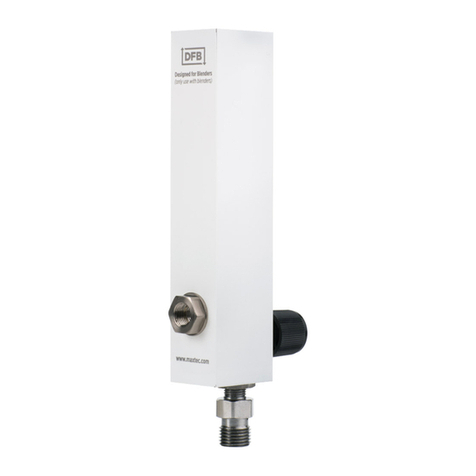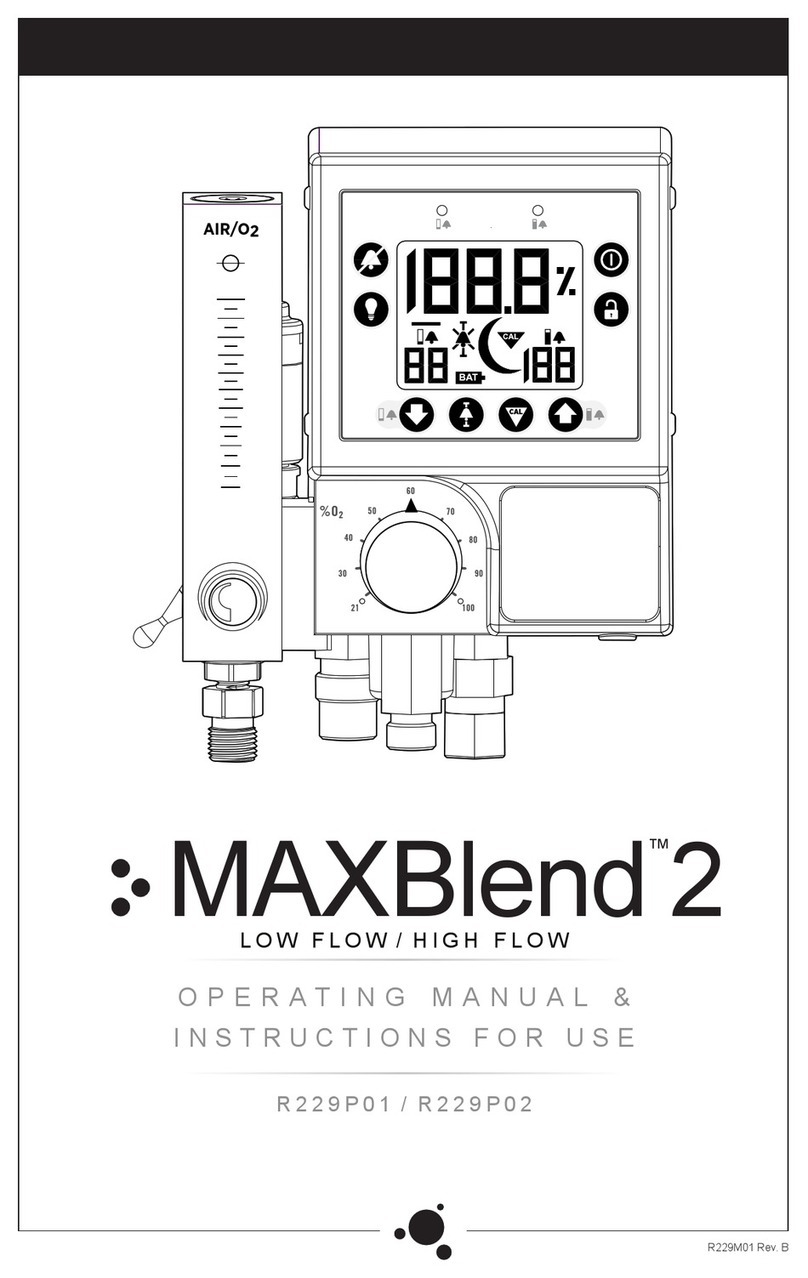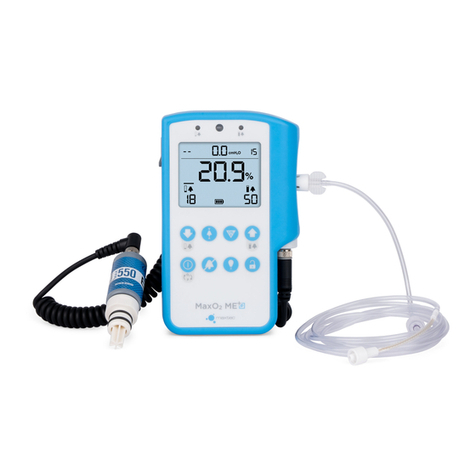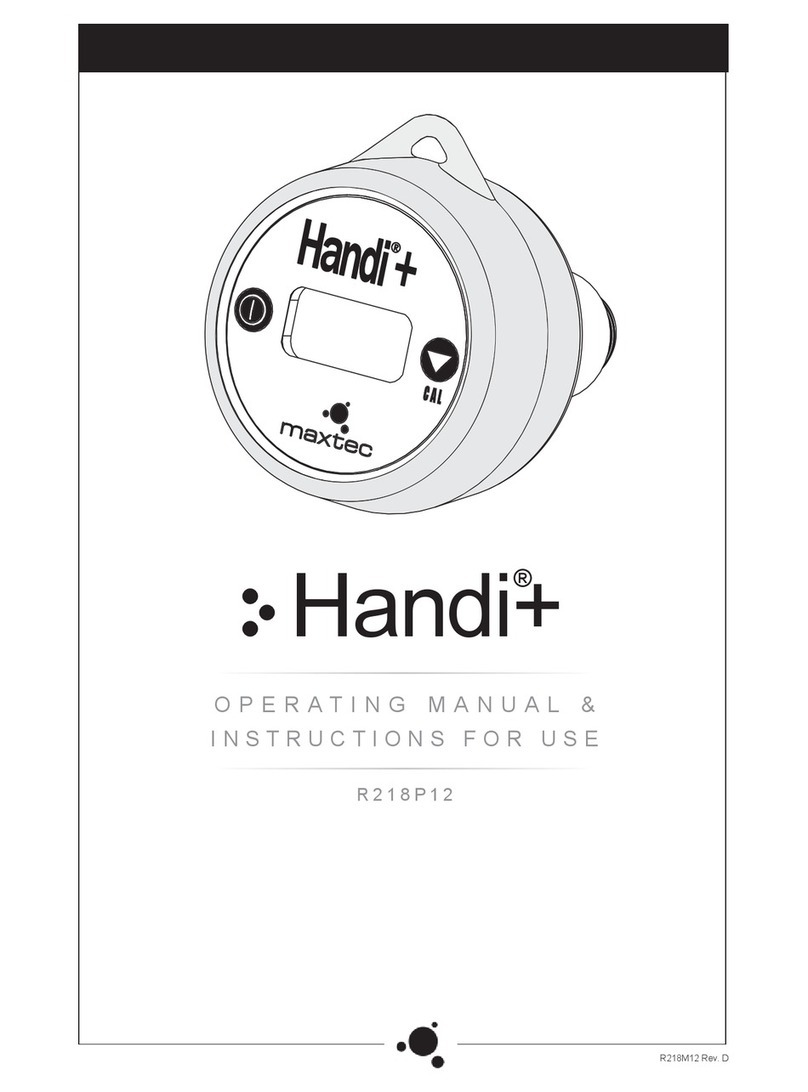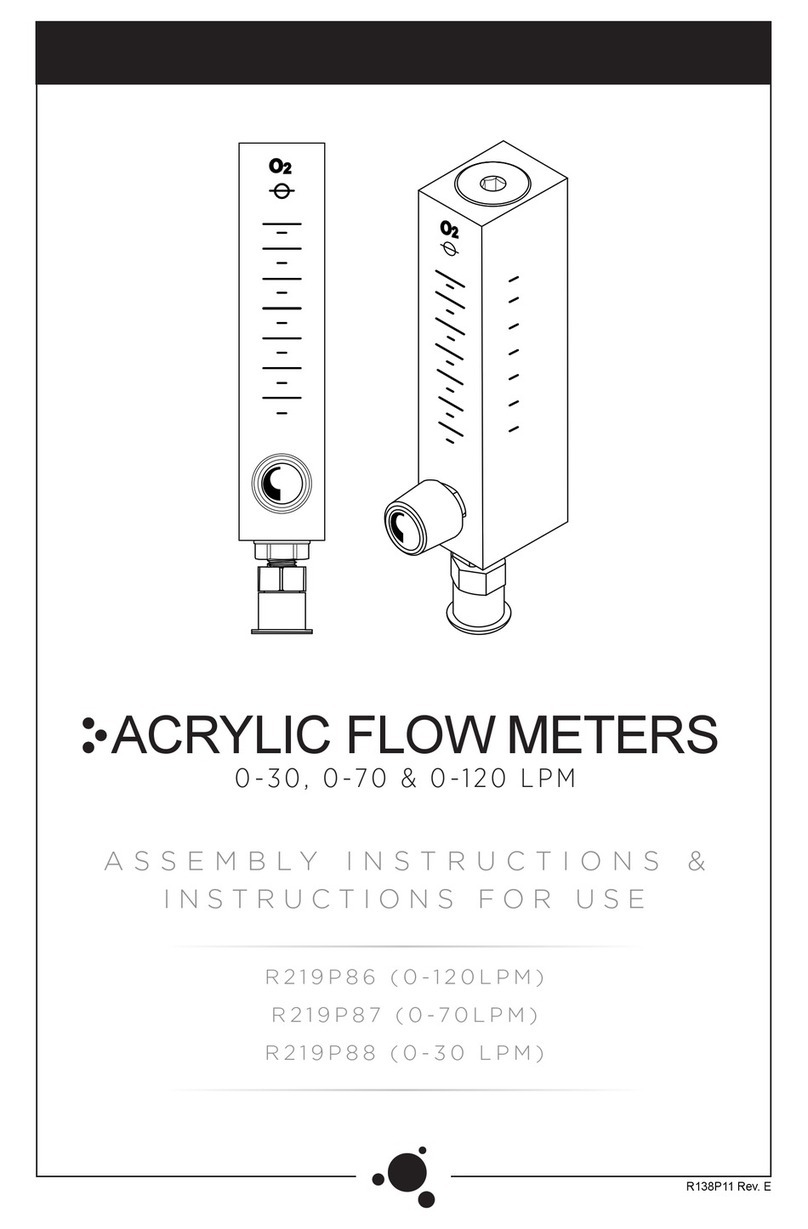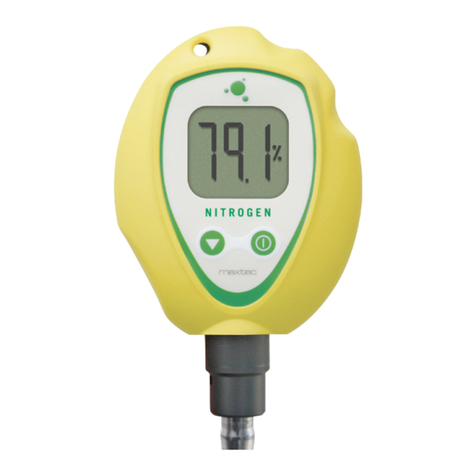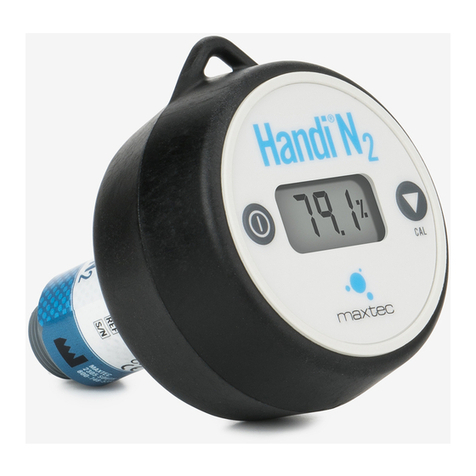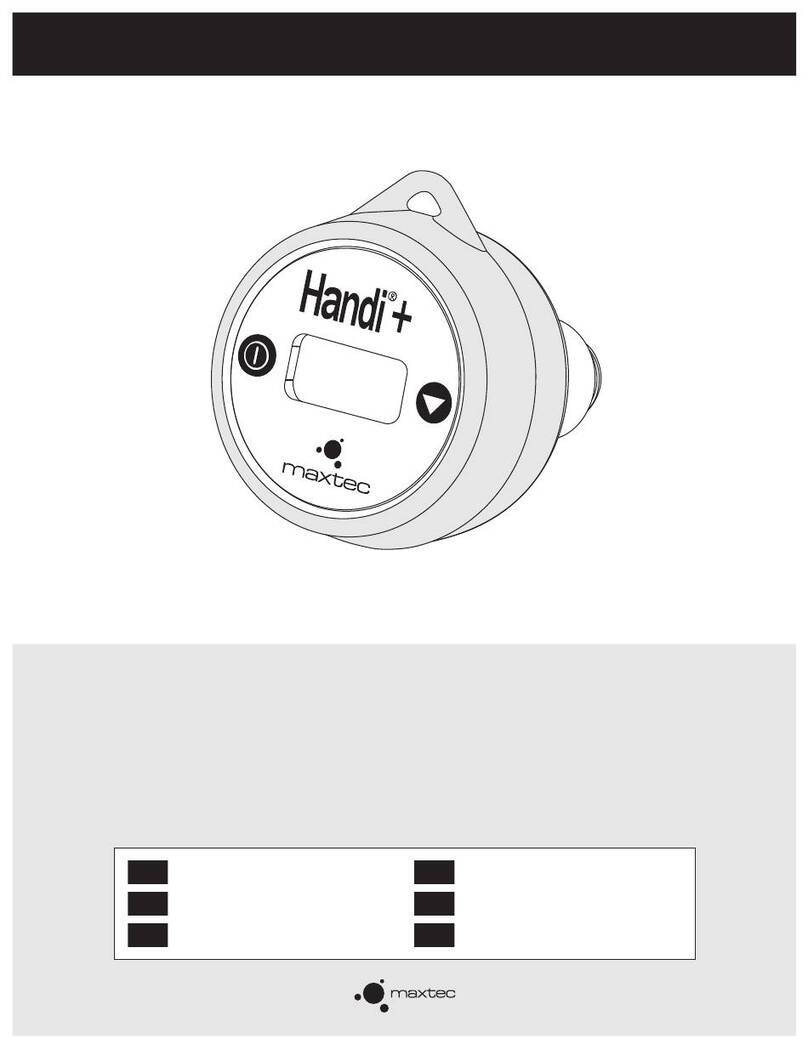
ENGLISH 2WWW.MAXTEC.COM • (800) 748-5355
CLASSIFICATION
Protection against electric shock.................................................... internally powered equipment
Protection against water................................................................................................................IPX1
Mode of operation..............................................................................................................Continuous
Flammable anesthetic mixture ..............................................Not suitable for use in the presence
of a flammable anesthetic mixture
Product Disposal Instructions:
The sensor, batteries, and circuit board are not suitable for regular trash dis-
posal. Return sensor to Maxtec for proper disposal or dispose according to local
guidelines. Follow local guidelines for disposal of other components.
WARRANTY
Provided the device is properly maintained and under normal operating conditions, Maxtec
warrants the MaxVenturi to be free from defects of workmanship or materials for a period of 2
years from the date of shipment from Maxtec. Based on Maxtec’s product evaluation, Maxtec’s
sole obligation under the foregoing warranty is limited to making replacements, repairs, or
issuing credit for equipment found to be defective. This warranty extends only to the buyer
purchasing the equipment directly from Maxtec or through Maxtec’s designated distributors
and agents as new equipment.
Maxtec warrants the MAX-250E oxygen sensor in the MaxVenturi to be free from defects
in material and workmanship for a period of 2 years from Maxtec’s date of shipment in a
MaxVenturi unit. Should a sensor fail prematurely, the replacement sensor is warranted for
the remainder of the original sensor warranty period.
Routine maintenance items, such as batteries, are excluded from warranty. Maxtec and any
other subsidiaries shall not be liable to the purchaser or other persons for incidental or conse-
quential damages or for equipment that has been subject to abuse, misuse, misapplication,
alteration, negligence or accident.
THESE WARRANTIES ARE EXCLUSIVE AND IN LIEU OF ALL OTHER WARRANTIES, EXPRESSED OR IMPLIED,
INCLUDING WARRANTY OF MERCHANTABILITY AND FITNESS FOR A PARTICULAR PURPOSE.
WARNINGS
Indicates a potentially hazardous situation, if not avoided, could result in death or serious
injury.
◆ This device is not intended for use with life supporting devices/systems.
◆ Failure to comply with the warnings and precautions in this manual could result in instru-
ment damage and possibly jeopardize the wellbeing of the patient and/or health care
professional. Improper use of this device can cause inaccuracy of flow and oxygen read-
ings which can lead to improper treatment, hypoxia or hyperoxia, or other patient injury or
discomfort. Follow the procedures outlined in this user manual.
◆ Not for use in an MRI environment.
◆ If the O2% drifts away from the level to which it was set, check to make sure the nasal prongs
on the patient interface are not occluded by sputum or the nasal septum. Flow restriction
to the circuit or patient interface will cause the oxygen level to increase. Flow restriction
downstream of the venturi unit will not be detected by the flow meter.
◆ This device does not have any alarms for interruption in oxygen supply.
◆ Allow oxygen reading to stabilize before adjusting oxygen content.
◆ This device does not have any alarms for oxygen level high or low alarms.
◆ Never allow excess length of tubing near the patient’s head or neck which could result in
strangulation.
◆ Use only Maxtec replacement sensors. Use of any other sensor will void warranty and may
lead to product damage, product malfunction, improper treatment to patient, hypoxia, or
hyperoxia.
DO NOT use this device near any type of flame or flammable/explosive substances,
vapors or atmosphere. Operating the oxygen analyzer in these environments may result
in fire or explosion.
◆ This device in its entirety (including electronics) is not suitable for use in the presence of
flammable anaesthetic mixtures or in an atmosphere of explosive gases. Operating the oxy-
gen analyzer in these environments may result in fire or explosion.
DO NOT attach a humidifier or any other source gas to the room air inlet. It should be
occupied at all times by the filter listed in the disposables list. The inlet filter prevents
entrainment of ambient contamination and silences venturi noise. The filter provided
with the MaxVenturi is single-patient use only.
◆ Use of this device with a pressurized oxygen bottle may result in inaccurate oxygen con-
centration readings when used above 40 LPM and at high oxygen concentrations. High tank
pressures result in cooling oxygen supply temperatures which affect the accuracy of the
oxygen sensor. It is suggested that the device be connected with a long supply hose. Use a 15
ft supply hose where possible — Maxtec P/N (R127P35).
◆ Use patient circuits that are approved for use with the manufacturer’s humidifier as listed in
their individual instructions for use.
DO NOT attempt to clean the inside of the flow meter. If any malfunction is detected in the
function of the flow meter, if any debris or contamination is detected in the flow meter, or
if the float sticks in the flow tube, discontinue use immediately and return the device to
Maxtec for service.
◆ Never install the sensor in any location other than the sensor port in the device.
SENSOR WARNINGS: The Maxtec MAX-250 oxygen sensor is a sealed device containing a mild
acid electrolyte, lead (Pb), and lead acetate. Lead and lead acetate are hazardous waste con-
stituents and should be disposed of properly, or returned to Maxtec for proper disposal or
recovery.
Conforms to:
AAMI STD ES60601-1, ISO STD
80601-2-55, IEC STDS 60601-
1-6, 60601-1-8 & 62366
Certified to:
CSA STD C22.2 No. 60601-1
NOTE: The latest edition of this operating manual can be downloaded from our website at www.maxtec.com
Maxtec
2305 South 1070 West
Salt Lake City, Utah 84119
USA
phone: (800) 748.5355
fax: (801) 973.6090
email: sales@maxtec.com
web: www.maxtec.com
EN Instructions for Use
